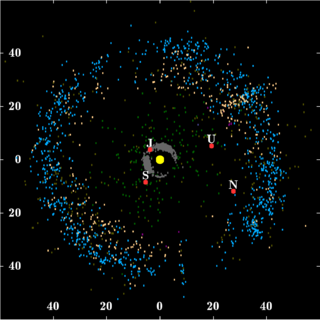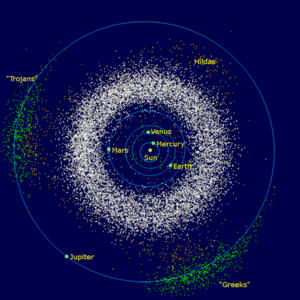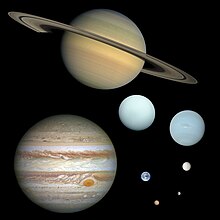
An asteroid is a minor planet—an object that is neither a true planet nor a comet—that orbits within the inner Solar System. They are rocky, metallic, or icy bodies with no atmosphere. The size and shape of asteroids vary significantly, ranging from small rubble piles under a kilometer across to Ceres, a dwarf planet almost 1000 km in diameter.

The Kuiper belt is a circumstellar disc in the outer Solar System, extending from the orbit of Neptune at 30 astronomical units (AU) to approximately 50 AU from the Sun. It is similar to the asteroid belt, but is far larger—20 times as wide and 20–200 times as massive. Like the asteroid belt, it consists mainly of small bodies or remnants from when the Solar System formed. While many asteroids are composed primarily of rock and metal, most Kuiper belt objects are composed largely of frozen volatiles, such as methane, ammonia, and water. The Kuiper belt is home to most of the objects that astronomers generally accept as dwarf planets: Orcus, Pluto, Haumea, Quaoar, and Makemake. Some of the Solar System's moons, such as Neptune's Triton and Saturn's Phoebe, may have originated in the region.

The Oort cloud, sometimes called the Öpik–Oort cloud, is theorized to be a vast cloud of icy planetesimals surrounding the Sun at distances ranging from 2,000 to 200,000 AU. The concept of such a cloud was proposed in 1950 by the Dutch astronomer Jan Oort, in whose honor the idea was named. Oort proposed that the bodies in this cloud replenish and keep constant the number of long-period comets entering the inner Solar System—where they are eventually consumed and destroyed during close approaches to the Sun.

The Solar System is the gravitationally bound system of the Sun and the objects that orbit it. It was formed 4.6 billion years ago when a dense region of a molecular cloud collapsed, forming the Sun and a protoplanetary disc. The Sun is an ordinary main sequence star that maintains a balanced equilibrium by the fusion of hydrogen into helium at its core, releasing this energy from its outer photosphere.
A trans-Neptunian object (TNO), also written transneptunian object, is any minor planet in the Solar System that orbits the Sun at a greater average distance than Neptune, which has an orbital semi-major axis of 30.1 astronomical units (au).

In planetary astronomy, a centaur is a small Solar System body that orbits the Sun between Jupiter and Neptune and crosses the orbits of one or more of the giant planets. Centaurs generally have unstable orbits because they cross or have crossed the orbits of the giant planets; almost all their orbits have dynamic lifetimes of only a few million years, but there is one known centaur, 514107 Kaʻepaokaʻawela, which may be in a stable orbit. Centaurs typically exhibit the characteristics of both asteroids and comets. They are named after the mythological centaurs that were a mixture of horse and human. Observational bias toward large objects makes determination of the total centaur population difficult. Estimates for the number of centaurs in the Solar System more than 1 km in diameter range from as low as 44,000 to more than 10,000,000.

Sedna is a dwarf planet in the outermost reaches of the inner Solar System, orbiting the Sun beyond the orbit of Neptune. Discovered in 2003, the planetoid's surface is one of the reddest known among Solar System bodies. Spectroscopy has revealed Sedna's surface to be mostly a mixture of the solid ices of water, methane, and nitrogen, along with widespread deposits of reddish-colored tholins, a chemical makeup similar to those of some other trans-Neptunian objects. Within the range of uncertainties, it is tied with the dwarf planet Ceres in the asteroid belt as the largest dwarf planet not known to have a moon. Its diameter is roughly 1,000 km. Owing to its lack of known moons, the Keplerian laws of planetary motion cannot be employed for determining its mass, and the precise figure as yet remains unknown.

The scattered disc (or scattered disk) is a distant circumstellar disc in the Solar System that is sparsely populated by icy small Solar System bodies, which are a subset of the broader family of trans-Neptunian objects. The scattered-disc objects (SDOs) have orbital eccentricities ranging as high as 0.8, inclinations as high as 40°, and perihelia greater than 30 astronomical units (4.5×109 km; 2.8×109 mi). These extreme orbits are thought to be the result of gravitational "scattering" by the gas giants, and the objects continue to be subject to perturbation by the planet Neptune.

There is evidence that the formation of the Solar System began about 4.6 billion years ago with the gravitational collapse of a small part of a giant molecular cloud. Most of the collapsing mass collected in the center, forming the Sun, while the rest flattened into a protoplanetary disk out of which the planets, moons, asteroids, and other small Solar System bodies formed.

According to the International Astronomical Union (IAU), a minor planet is an astronomical object in direct orbit around the Sun that is exclusively classified as neither a planet nor a comet. Before 2006, the IAU officially used the term minor planet, but that year's meeting reclassified minor planets and comets into dwarf planets and small Solar System bodies (SSSBs). In contrast to the eight official planets of the Solar System, all minor planets fail to clear their orbital neighborhood.

The Nicemodel is a scenario for the dynamical evolution of the Solar System. It is named for the location of the Côte d'Azur Observatory—where it was initially developed in 2005—in Nice, France. It proposes the migration of the giant planets from an initial compact configuration into their present positions, long after the dissipation of the initial protoplanetary disk. In this way, it differs from earlier models of the Solar System's formation. This planetary migration is used in dynamical simulations of the Solar System to explain historical events including the Late Heavy Bombardment of the inner Solar System, the formation of the Oort cloud, and the existence of populations of small Solar System bodies such as the Kuiper belt, the Neptune and Jupiter trojans, and the numerous resonant trans-Neptunian objects dominated by Neptune.

(120216) 2004 EW95 (provisional designation 2004 EW95) is a resonant trans-Neptunian object in the Kuiper belt located in the outermost regions of the Solar System. It measures approximately 291 kilometers in diameter. It has more carbon than typical of KBOs, and the first to be confirmed as having this composition in this region of space. It is thought to have originated closer to the Sun, perhaps even in the main asteroid belt.
The five-planet Nice model is a numerical model of the early Solar System that is a revised variation of the Nice model. It begins with five giant planets, the four that exist today plus an additional ice giant between Saturn and Uranus in a chain of mean-motion resonances.

The following outline is provided as an overview of and topical guide to the Solar System:
The jumping-Jupiter scenario specifies an evolution of giant-planet migration described by the Nice model, in which an ice giant is scattered inward by Saturn and outward by Jupiter, causing their semi-major axes to jump, and thereby quickly separating their orbits. The jumping-Jupiter scenario was proposed by Ramon Brasser, Alessandro Morbidelli, Rodney Gomes, Kleomenis Tsiganis, and Harold Levison after their studies revealed that the smooth divergent migration of Jupiter and Saturn resulted in an inner Solar System significantly different from the current Solar System. During this migration secular resonances swept through the inner Solar System exciting the orbits of the terrestrial planets and the asteroids, leaving the planets' orbits too eccentric, and the asteroid belt with too many high-inclination objects. The jumps in the semi-major axes of Jupiter and Saturn described in the jumping-Jupiter scenario can allow these resonances to quickly cross the inner Solar System without altering orbits excessively, although the terrestrial planets remain sensitive to its passage.

2012 VP113, also known by its nickname "Biden", is a trans-Neptunian object of the sednoid population, located in the outermost reaches of the Solar System. It was first observed on 5 November 2012 by American astronomers Scott Sheppard and Chad Trujillo at the Cerro Tololo Inter-American Observatory in Chile. The discovery was announced on 26 March 2014. The object probably measures somewhere between 300 and 1000 km in diameter, possibly large enough to be a dwarf planet.

















